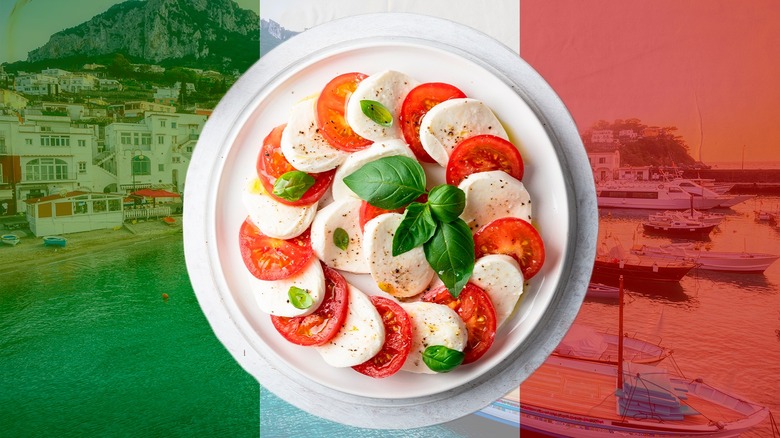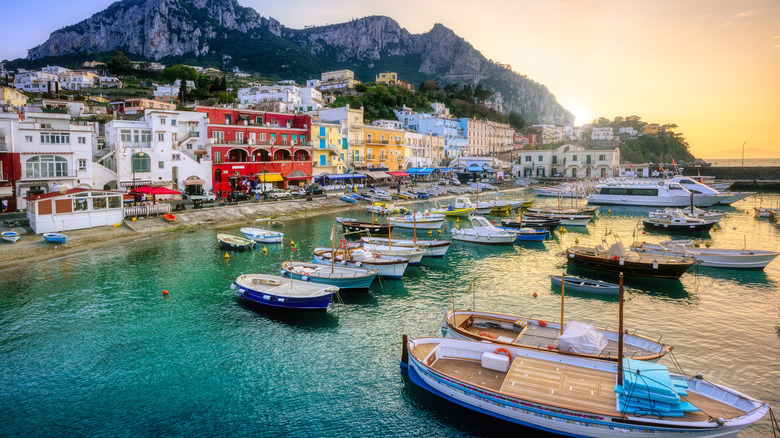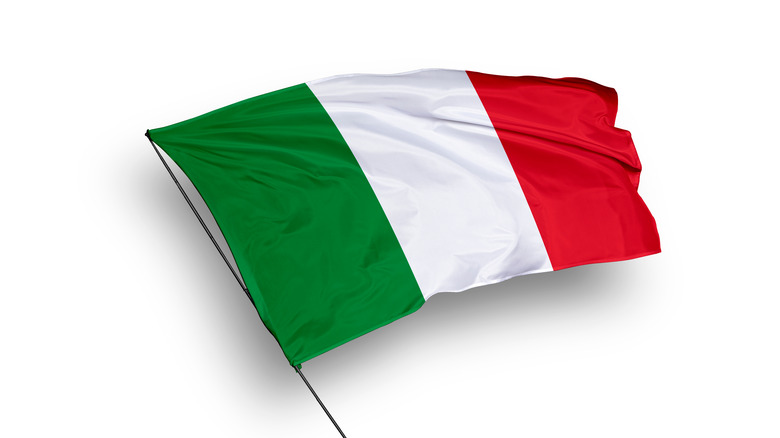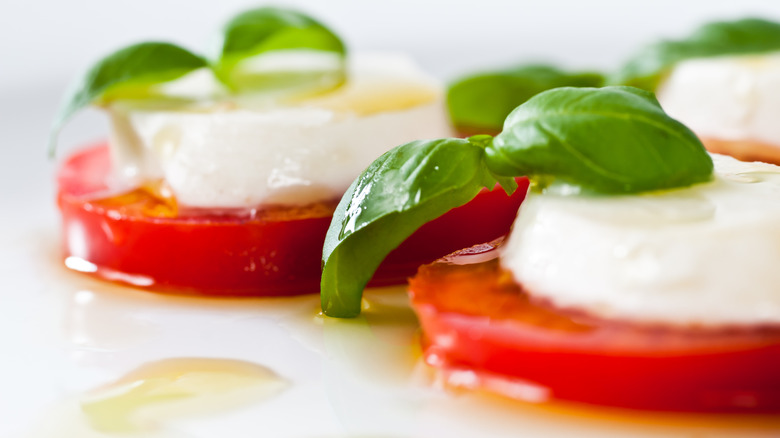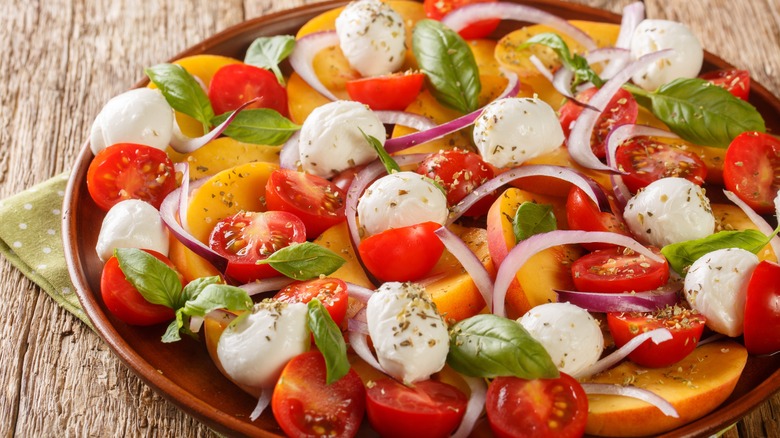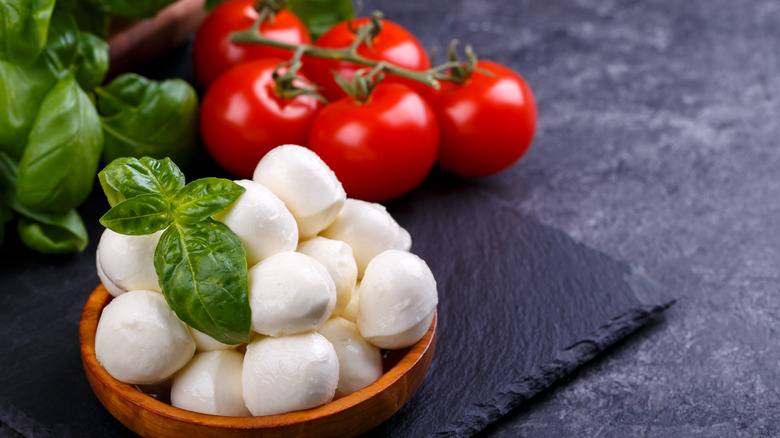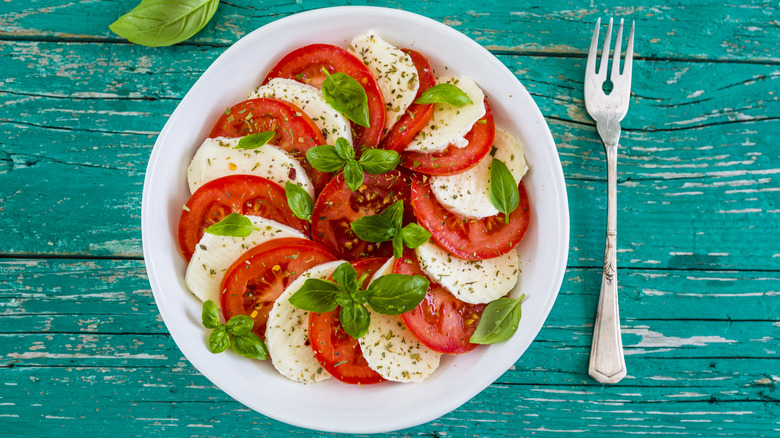The Patriotic Origins Of The First Caprese Salad
When you're craving a fresh dish but a basic green salad seems boring, why not try a Caprese salad? Caprese salad is an Italian dish made with fresh mozzarella cheese, vine-ripened tomatoes, and fragrant basil leaves; all layered for a spectacular presentation. The Caprese salad is truly an Italian meal with the bright colors of the Italian flag. The minimalist salad has only three ingredients, four if you count the extra virgin olive oil that is often drizzled on top. You might think with so few ingredients that, the salad would leave much to be desired in the taste department, but it's actually the opposite. The creaminess of the fresh mozzarella contrasting the acidity of the fresh tomatoes and the basil adds just enough fragrant aroma that the flavors blend seamlessly. The olive oil on top ties it together and keeps any one of the flavors from taking over, so you get a fresh taste in each bite.
All the ingredients in a Caprese salad are classic Italian staples, so it's no surprise that this salad was created in Italy. However, it's unclear who originally put these ingredients together. There are a few theories, but regardless of the exact inventor, there's no denying the patriotic origins of the Caprese salad. It doesn't matter if the history is a bit murky — this salad is a truly Italian dish that always pleases.
Caprese Salad was born on the Island of Capri
Caprese salad was named for the island of Capri, where it is believed to have been created. Capri is in the southern region of Campania in the blue waters of the Bay of Naples. The island feels and looks like paradise. Throughout history, the rich and famous have spent time on the island, and bohemian artists and writers were inspired by the island's natural beauty. It is easy to understand how the warm weather would lead to the creation of a light salad like the Caprese.
Capri was part of the Roman empire, and some legends claim Roman Emperor Augustus, who lived on the island during the first century A.D., had an indirect hand in the creation of the Caprese salad. The legend claims that his successor Tiberius was the first to come up with combining creamy mozzarella, bright tomatoes, and fresh basil.
While it would be lovely to trace a classic Italian dish to the Romans, the only problem is that tomatoes, now forever connected with Italian cuisine, didn't arrive in Italy or the rest of Europe until early in the 16th century. Tomatoes are native to South America and then made their way North to the Aztecs in Mexico. Later, the Spanish conquistadors conquered Mexico and brought tomatoes to Europe. At first, Europeans were skeptical of these strange new fruits and only used them as decoration. They didn't start consuming them until almost 200 years after their unceremonious arrival.
A patriotic mason
The rise of patriotism post-World War I may have played a role in the first Caprese salad. When the First World War ended in 1918, it took a toll on Italy. While Italy was technically on the winning side, allied with Britain and France, many battles were fought on Italian soil. Combat was intense, and Italy lost 460,000 men, and 955,000 were injured. During this post-war time, the country started rebuilding, and citizens sought strength in patriotism and camaraderie. That patriotism is the thread that holds together one origin story of the Caprese salad.
One popular theory claims that a local mason wanted to show his pride in his homeland and created the Caprese salad. His recipe was never meant to be a great culinary invention — the mason was simply looking to make a meal with the patriotic colors of the Italian flag. He was inspired by his optimism for the new future of Italy and his countrymen and women. While it is impossible to fact-check this story, it is a tale about hope and the power of food to bring people together.
Founder of futuristic food
Another theory on the origins of the Caprese salad comes from the writer, poet, and founder of the futuristic movement Filippo Tommaso Marinetti. The futuristic movement focused on looking forward to the future and technology. In 1909, Marinetti published his manifesto, "The Manifesto of Futurism," where he explained his futuristic ideas and the connection between technology, art, and lifestyle. The movement rejected old ideas and philosophies to make space for the innovative and new. These futuristic ideas expanded to food too.
Later, Marinette published "Manifesto of Futurist Cooking," which criticized Italian foods, especially pasta. He wanted Italians to change their diets to change their mindsets. He hated pasta and thick sauces and believed that the future was about simplistic eating with light foods that wouldn't weigh down the mind and body.
The story goes that when the eccentric Marinette visited the island of Capri to speak at a conference, the hotel chefs created the Caprese salad for him as a nod toward his fervent ideology about the importance of fresh local ingredients and shunning heavy foods. Some of Marinetti's ideas were outlandish, but his focus on eating fresh local foods is now an accepted food philosophy that many popular chefs follow.
Exiled King Farouk of Egypt
After the futuristic food movement lost momentum, the Caprese salad wasn't seen on the menu until the early 1950s when Egyptian King Farouk asked for a light meal while living in exile on Capri. King Farouk spent his leisurely days on the island of Capri, where he rubbed elbows with the rich, the famous, and the artistic. He was quite an influencer at the time, and when he asked the local chefs to make him something light yet satisfying, they made him a Caprese salad. Word quickly got around the island that the King ate this salad, and it became popular once again.
Capri was a well-visited island, and tourists from all over came to take a dip in the water and enjoy the island's beauty. And when they returned to their respective countries, many were excited to share about the quaint little salad — made with the colors of Italy — that Egyptian royalty loved. And from there, the rest is history.
Today's Caprese salad
The classic Caprese salad has endured over the years, with some chefs making small changes, like adding a drizzle of balsamic reduction. But other chefs have reinvented the classic Caprese with new flavor twists and turns. Traditionally Caprese salad was only made with heirloom tomatoes, but now you can find it on menus with cherry tomatoes, Romas, and even San Marzano tomatoes. While fresh mozzarella is the preference for a Caprese salad, some chefs use creamy burrata. Burrata has a soft middle, so cutting it into slices is impossible, so when chefs use burrata, it's added on top of the tomatoes and basil rather than layered.
Another fun way that chefs reinvent Caprese salad is by adding fresh fruit like peaches or pears. For those that want the same color scheme but with new flavors, try adding strawberries and avocados to a Caprese salad to create a variety of textures and tastes while still keeping the salad's patriotic color scheme.
The simplicity of a Caprese salad makes it a good canvas for adding new and different ingredients. So get inspired and try a non-traditional Caprese salad; you may be surprised by how much you like it.
Start with fresh ingredients
When it comes to Caprese salad, fresh is best, and it all starts with fresh tomatoes. So head to the farmers market instead of the grocery store for ripe tomatoes. If you live in the North, save your Caprese salad for the warmer months when the tomatoes are at their best. Winter tomatoes are often bland and watery.
An authentic Caprese salad uses buffalo mozzarella, which is made with water buffalo milk in certain regions of Italy. You won't find it in your local grocery store. Buffalo mozzarella has a distinct, tangy flavor and creamy texture that is superior to other types of mozzarella. The unique taste of buffalo mozzarella makes it a coveted cheese for a Caprese salad. But if you can't find this specialty cheese, the next best thing is mozzarella from cow's milk called fior di latte. It is more widely available in supermarkets and makes a decent substitute for authentic buffalo mozzarella. However, steer clear of low-fat mozzarella that is sold in bricks at the store, as it is not ideal for a Caprese salad. Not only does it lack the velvety creaminess, but the flavor will ruin your Caprese salad.
As for basil, use fresh basil leaves, and for the best presentation, keep the leaves whole and add them right before serving. A Caprese salad is defined by freshness, and this is not a make-ahead salad.
Tips to make an amazing Caprese salad every time
The Caprese is a simple salad, but there are a few tips and tricks to ensure it is always delicious. Starting with the tomatoes, choose tomatoes that are ripe but not overripe. They should be plump and firm so that they hold their shape. After slicing the tomatoes, sprinkle a little salt and set them aside. The salt will add flavor and help take out some of the moisture. Too much moisture is the enemy of a good Caprese salad,
When it comes to fresh mozzarella, it should be served at room temperature. The best way to prepare fresh mozzarella for a Caprese salad is to remove it from the refrigerator and place the ball on a plate with paper towels. Mozzarella needs to rest and dry out before slicing if you're going to achieve the firm texture necessary for the salad.
Now, you already know to use fresh basil, but did you know you shouldn't cut fresh basil leaves with a knife? Cutting fresh basil with a knife starts the oxidation process and turns your pretty green leaves brown, making for an unappetizing Caprese salad. If you want to break the leaves apart, tearing them with your fingers is fine, and they will keep their color.
And lastly, keep it simple and avoid adding too many extras. Have fun making different styles of Caprese salad, but avoid overdoing it, as the salad will quickly become an overcrowded dish with an overly complicated flavor.
